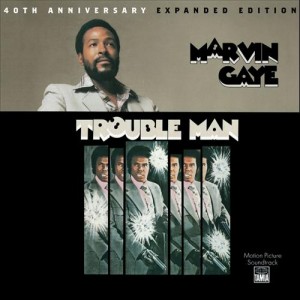Marvin Gaye: Trouble Man Liner Notes
A quick snapshot of Marvin Gaye, May 1971: Sylmar, California. It’s a rarely documented time in the artist’s life. He’d just finished What’s Going On, and hopped a flight from Detroit to Los Angeles to begin a co-starring role in an earnest film about a young Green Beret. He’s 32, newly shorn of the iconic beard that would characterize his creative gestation. In the summer of ’71, Marvin Gaye is an actor.
The film was not going swimmingly, the director uncommunicative with him, and Marvin was adrift in a world he’d known only as a fan, unaccustomed to set-politics, but ready to learn. It’s no surprise where Gaye found a home—on the camera truck, helping with the film operators, being close to the artistic creation of the film’s feel and look. Most of the camera crew was unaware of Gaye’s recorded work.
“He didn’t talk about it much,” remembers cinematographer John Toll, then an assistant. “We just knew him as a lanky, friendly guy who asked a lot of questions about the process. We talked a lot about football too. He became one of us.”
The movie would ultimately be called Chrome and Hot Leather, and Gaye’s performance as Jim is a nice reminder of what could have been. He had the looks, and the charisma, the beginnings of real acting craft, but Marvin Gaye’s summer adventure in the world of cinema would soon lead him to a different creative hot spot. It was a time when Shaft and Superfly were both hits, with successes spun largely from the bravura soundtrack work of Isaac Hayes and Curtis Mayfield. The genre became known as “Blaxploitation,” but in the day these films held a noble purpose. They were films made by and for a black audience. Their subtext was a powerful statement on the growing feelings of entitlement and self-respect sweeping young black America. And when the producers of Trouble Man came calling for Marvin Gaye to provide the soundtrack to their film, Gaye answered quickly. It would offer a transition to his life after What’s Going On, a busman’s holiday before heading back into the ring for Let’s Get It On and all that would follow.
I’m often asked about music in film. It’s a personal passion, getting that marriage between cinema and music right. It’s rarely easy. Music is often its own great movie; it doesn’t need a partner, it lives in your head as you listen with eyes closed. Ah, but when the magic of a performance unites with the perfect soundtrack, it’s forever. The best music for film is largely invisible, like an emotional breeze wafting through a movie, suggesting and never demanding. It’s a craft, an art form all its own, and the best composers know how to work from the inside out. They steep themselves in the beating heart of the characters, the emotional adventure of the movie. Done correctly, in films like Rain Man, or Paris, Texas, or Local Hero, the music becomes a character, as important as any actor on screen, a partner to the director.
Recording the Trouble Man soundtrack was a stellar opportunity for Marvin. He was fresh and free, unbound by the commercial demands of the first and second acts of his career, and the results are unique in his body of work. It’s the first time he’s recording in service of a finished film, but Marvin’s Trouble Man music is his own. It swings, it delivers, it’s holy and subversive, and, forty years later, still towers mightily over much of what passes for film composition today.
While the studio clearly wanted a well-known pop star to sell a single, Marvin took the job personally. Having internalized the lessons he’d learned hanging on the camera truck in Sylmar, making Chrome and Hot Leather a year earlier, he knew where and how to brew a vibe that could characterize a movie. He also added lyrics that not only captured the world of Mr. T, the rogue star of the story, he raised the ambitions of the whole movie, even adding lyrics that applied to his own creative life: I didn’t make it, sugar, playing by the rules…
Watching the film today is a treat, like eating in a diner with a Picasso on the wall. We’re left to wonder whether Trouble Man was a peek at a future destination, a natural outlet for the music that poured out of Marvin Gaye, or was it a glorious one-off? In typical fashion, with a little digging, you can find a passionate answer from the artist himself.
It’s October 1976, and Marvin is being interviewed in England for the release of I Want You. On the other side of the microphone is the esteemed journalist and music historian Paul Gambaccini. It’s a high-water mark for both of them, one of Gaye’s best interviews, and sure enough, when they stop at Trouble Man, Marvin has a lot to say.
“The Trouble Man film score was one of my loveliest projects, and one of the great sleepers of our time,” Gaye announces casually. “I’ll probably be dead and gone before I get the probable acclaim from the Trouble Man album, the musical track, that I feel I should get. If somebody took that album and did a symphony on it, I think it would be quite interesting…” He muses for a bit on the promise of his symphonic work before returning proudly to the subject of Trouble Man. “I enjoyed that job immensely, I enjoyed writing a film score. I’d love to do more. I think it’s probably some of my finer work.”
Courtesy of Hip-O Select – Cameron Crowe – November, 2012


